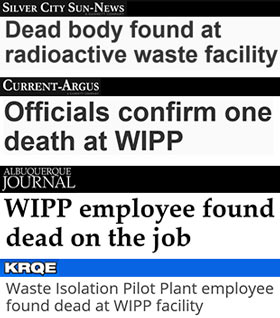– Concern for “full plutonium flash” at WIPP nuclear site that affects other drums and triggers spreading disaster — Plutonium-239 is a main radioactive material in drum that exploded — Anonymous Employee: The warnings were ignored… “They put us in danger” (ENENews, June 8, 2014):
Sante Fe New Mexican, June 9, 2014: On the night of Feb. 14, waste in an underground salt cavern in Southern New Mexico created so much heat the drum’s lid cracked. Radiation leaked out. Heavy bags of magnesium oxide stacked on top of the containers to prevent leaks shifted and disintegrated from the force of the reaction. […] The parent waste drum came from a waste stream including liquids such as hydrochloric and nitric acids, kerosene, methanol, silicone oil, nitrate salts, heavy metals and two main radioactive isotopes — plutonium-239 [the primary fissile isotope used for the production of nuclear weapons] and uranium-238. Ascarite, diatomaceous earth, vermiculite and kitty litter were added to soak up any liquids. […] “A lot of the drums we opened up had a lot of liquid,” said one former employee familiar with the process, who spoke on condition of anonymity because he was not authorized to speak with the media. […] EnergySolutions also switched from a clay-based kitty litter to Swheat, an organic kitty litter, for absorbing fluids. It is unclear why the contractor made the switch or whether LANL approved the switch, and lab officials wouldn’t comment. The former employee familiar with the repackaging process said EnergySolutions staff tried to warn the company’s administrators that the switch in kitty litter was a bad idea. The nitrate salts and the wheat-based kitty litter created a combustible mix, according to chemists. The warnings were ignored, the employee said. “They put us in danger, too,” he said. EnergySolutions did not respond to multiple requests for comment […]
Read moreConcern for ‘FULL PLUTONIUM FLASH’ at WIPP nuclear site that affects other drums and triggers spreading disaster – Plutonium-239 is a main radioactive material in drum that exploded – Anonymous Employee: The warnings were ignored … ‘They put us in danger’






